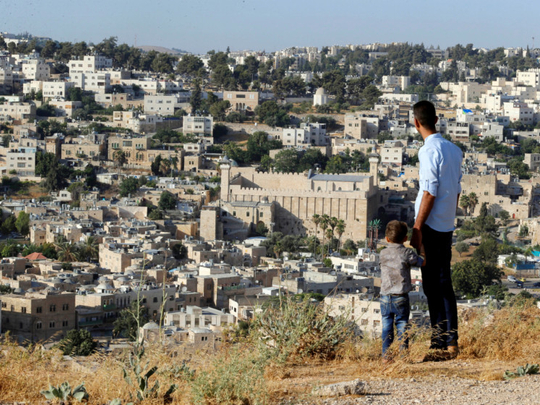
Two symbolic, but crucially important decisions were adopted last week by Unesco’s World Heritage Committee concerning occupied East Jerusalem and the old city of Hebron in the West Bank. The first resolution stated that all “legislative and administrative measures and actions taken by Israel, the occupying power, which have altered or purport to alter the character and status of the Holy City of Jerusalem, and in particular, the ‘basic law’ on Jerusalem, are null and void and must be rescinded forthwith”. The decision in effect disavows Israeli sovereignty over occupied East Jerusalem, which was occupied in the 1967 war.
The second resolution recognises the old city of Hebron and Al Ebrahimi Mosque as Palestinian heritage sites that are in danger. In both cases, Israel and the United States tried to scuttle the vote and failed. In response, Israeli Prime Minister Benjamin Netanyahu condemned the vote and ordered another slash in Israel’s annual contribution to Unesco. He described the Hebron resolution as “another delusional decision” by the United Nations body. He announced that Israel will take measures to underline Jewish connection to the old city of Hebron and in particular Al Ebrahimi Mosque.
This is not the first time that Unesco has elicited angry Israeli and US reactions over resolutions pertaining to the status of occupied East Jerusalem, in particular the Old City. Last year, the organisation had passed a resolution denying Israeli sovereignty over occupied East Jerusalem. While condemning the move, Israel also claimed that more countries have either objected to the resolution or have abstained.
Jordan has been waging a diplomatic offensive against Israel’s unilateral and illegal actions in the Old City, especially in the area surrounding the Noble Sanctuary where Al Aqsa Mosque is located. The Western (Wailing) Wall is part of the foundations of the mosque, but is regarded as the holiest site for Jews. Since 1967 and the decision by the Israeli parliament to unify the city, Israel has been carrying out controversial excavation works that include digging underground tunnels that experts say threaten the foundations of Al Aqsa Mosque. Israel claims the Western Wall is part of the remains of Solomon’s Temple, which, according to Hebrew sources, was destroyed in 587BC. These claims have been contested by archaeological evidence.
For Jordan, maintaining the status of the Old City is more than a political objective. Under the 1994 peace treaty between Jordan and Israel, the Hashemite’s role as a custodian of Muslim sites in the holy city is recognised. Jordan carries out regular restoration projects of Muslim sites in the city. Until its occupation, East Jerusalem, which is part of the West Bank, was under Jordanian sovereignty. And even after Jordan had recognised the Palestine Liberation Organisation as the sole representative of the Palestinian people in 1974, it maintained custody of Muslim sites in East Jerusalem, chief among them is Al Haram Al Sharif that includes Al Aqsa Mosque. To date, it continues to administer Awqaf activities in the holy city. The Palestinian National Authority (PNA), which recognises Jordan’s special role over Muslim sites in occupied East Jerusalem, has admitted that the kingdom’s efforts have been fundamental in confronting and challenging unlawful Israeli activities in occupied East Jerusalem.
Peace treaty
Jordan’s relations with Israel have been tested frequently over the almost daily incursions by radical Jews of Al Haram Al Sharif. However, Amman’s efforts have succeeded so far in derailing plans to partition the mosque and allow Jewish prayers inside it. Jordan has been alone in fighting this battle and its success until now is testimony to its credibility. Fearing an extreme Jordanian reaction, that includes suspension of the peace treaty, Israel has backed off from carrying on with the partition plan.
Moreover, the peace treaty has enabled Jordan to challenge Israeli actions in occupied East Jerusalem and the West Bank in international forums. Jordan’s role was instrumental in bringing the issue of the separation barrier, which Israel has built in the West Bank, to the attention of the International Court of Justice (ICJ). In July 2004, the ICJ had said that the barrier Israel was building to seal off the West Bank violates international law because it infringes on the rights of Palestinians.
While Israel has rejected all UN resolutions regarding its occupation and unlawful activities in occupied East Jerusalem and the West Bank, it is important that Jordan, the PNA and the rest of Arab and Muslim states continue to apply diplomatic pressure. The latest resolutions underline the obvious facts about Israeli occupation and its unilateral actions. They may not stop Israel and its hardline leaders, but they provide additional evidence that incriminates it and keeps the prospects of international sanctions and penalties alive.
Israel has tried for decades to legalise its occupation and distort historical facts. The latest resolutions constitute a major setback to its sinister efforts. In the struggle to denounce the occupation and de-normalise it, symbolism is a key weapon. Israel’s attempt to hijack the cultural/religious identities of the holy cities of occupied Jerusalem and Hebron is one onslaught that can be thwarted.
Osama Al Sharif is a journalist and political commentator based in Amman.








